 Unique Art Manufacturing Company was an American toy company, founded in 1916, based in Newark, New Jersey at 200 Waverly Ave.
that made inexpensive toys, including wind-up mechanical toys, out of lithographed tin. One of its early products was a
wind-up toy featuring two tin boxers. Their packaging indicated that they also had a sales office and showroom located at
200 Fifth Avenue in New York City.
Unique Art Manufacturing Company was an American toy company, founded in 1916, based in Newark, New Jersey at 200 Waverly Ave.
that made inexpensive toys, including wind-up mechanical toys, out of lithographed tin. One of its early products was a
wind-up toy featuring two tin boxers. Their packaging indicated that they also had a sales office and showroom located at
200 Fifth Avenue in New York City.
The company scored a hit in the 1940's when it acquired the rights to a popular comic strip and released the
Li'l Abner Dogpatch Band for Christmas 1945. The windup toy featured Abner dancing, Pappy on drums, Mammy with a drum stick,
and Daisy Mae playing piano. Unique followed with a Howdy Doody band several years later. The company made a tinplate wind-up
toy called Unique Artie, which was a clown riding in a jeep-like vehicle similar to Marx's Jumpin
Jeep. Among many of the lithographed tinplate products that Unique Art made before and after World War II that had a train
related theme were Unique's version of the Honeymoon Express (pictured in an April 1945 Playthings Magazine ad), a Hobo
Train box car with a tramp on the catwalk being chased by a dog as the car moved across the floor, the Hillbilly Express
impulse gravity and mechanical powered back-and-forth locomotive on a short inclined track, an operating baggage man named
Finnegan who moved a clockwork powered cart, and the Lincoln Tunnel clockwork powered endless belt procession of vehicles.
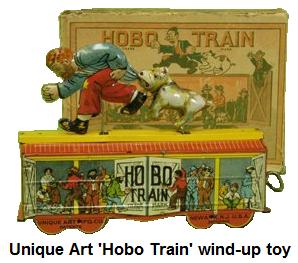 Unique's president, Sammy Bergman, was a good friend of toy magnate Louis Marx, and the two men's companies
at times cooperated, with Marx providing tooling to Unique and sometimes acting as a distributor for Unique's products.
The Unique Art Manufacturing wind-up animated Hobo Train appeared in the 1927 Marx Toy Catalog and a Sears catalog as the
Marx #48 Hobo Train. For a time, Marx listed Newark, NJ as a location for one of its toy manufacturing factories, despite
never actually owning a facility there.
Unique's president, Sammy Bergman, was a good friend of toy magnate Louis Marx, and the two men's companies
at times cooperated, with Marx providing tooling to Unique and sometimes acting as a distributor for Unique's products.
The Unique Art Manufacturing wind-up animated Hobo Train appeared in the 1927 Marx Toy Catalog and a Sears catalog as the
Marx #48 Hobo Train. For a time, Marx listed Newark, NJ as a location for one of its toy manufacturing factories, despite
never actually owning a facility there.
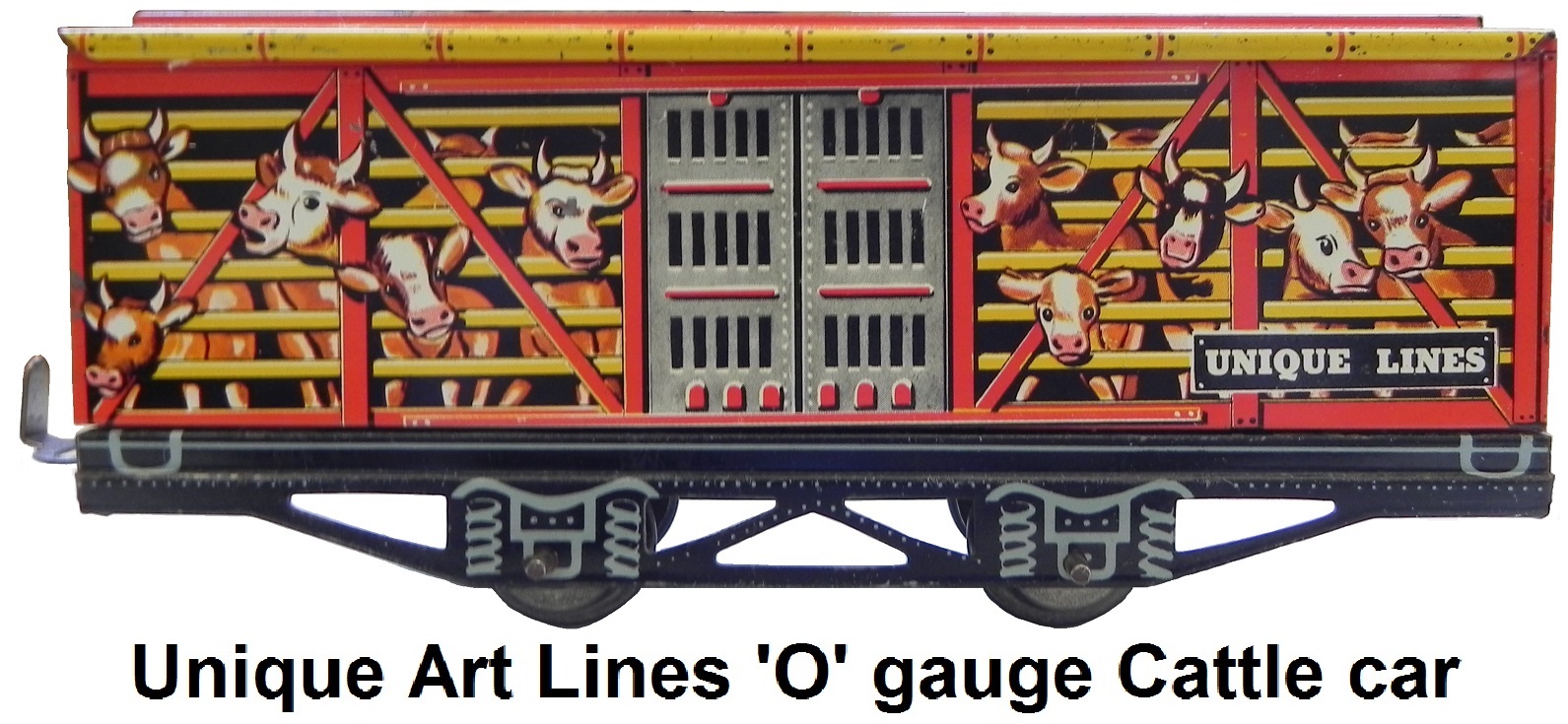 In 1949, Unique Art Manufacturing began producing colorful and detailed lithographed tin 'O' gauge toy trains, using tooling
of its own design along with some recycled tooling acquired from the defunct Dorfan Company that was
also located in Newark, New Jersey, but had ceased operations in 1934. Unique sold its trains in inexpensive ready to run
boxed sets. Unique had a distribution agreement with Jewel Tea, and also with Western Auto. The ready to run sets were
initially offered in clockwork 2-rail versions and then eventually in electric 3-rail. Sets were available as either freight
sets or passenger sets. All sets came with an 0-4-0 steam engine and 4-wheel tender. #742 was the number found on the
clockwork locomotive, and #1950 was used for the electric powered engine. While these engines were actually 0-4-0
configuration, with only 4 drivers, they had front and rear faux leading and trailing 4-wheel trucks lithographed into the
loco body so that they would appear to be 4-4-4's. The clockwork locomotives were offered with a bell and spark mechanism.
The electric powered engine was available with a working headlight or without the headlight. It is also found with an
electronic reversing unit or without. It was fitted with a universal motor that will run on AC or DC power. All sets included
track made by Unique Art. The electric powered set included a transformer, and a separate rheostat and directional remote
control button in a control tower trackside accessory.
In 1949, Unique Art Manufacturing began producing colorful and detailed lithographed tin 'O' gauge toy trains, using tooling
of its own design along with some recycled tooling acquired from the defunct Dorfan Company that was
also located in Newark, New Jersey, but had ceased operations in 1934. Unique sold its trains in inexpensive ready to run
boxed sets. Unique had a distribution agreement with Jewel Tea, and also with Western Auto. The ready to run sets were
initially offered in clockwork 2-rail versions and then eventually in electric 3-rail. Sets were available as either freight
sets or passenger sets. All sets came with an 0-4-0 steam engine and 4-wheel tender. #742 was the number found on the
clockwork locomotive, and #1950 was used for the electric powered engine. While these engines were actually 0-4-0
configuration, with only 4 drivers, they had front and rear faux leading and trailing 4-wheel trucks lithographed into the
loco body so that they would appear to be 4-4-4's. The clockwork locomotives were offered with a bell and spark mechanism.
The electric powered engine was available with a working headlight or without the headlight. It is also found with an
electronic reversing unit or without. It was fitted with a universal motor that will run on AC or DC power. All sets included
track made by Unique Art. The electric powered set included a transformer, and a separate rheostat and directional remote
control button in a control tower trackside accessory.

The freight cars offered were the #101 Hopper, #100 boxcar, a #107 cattle car, a high-sided gondola, 2
cabooses and a very hard to find crane that was made using the same dies and tooling as the Dorfan #610 Derrick. Passenger
trains had 2 #102 Pullman cars labeled City of Joplin or Garden City. These Unique Lines passenger cars were also made using
the acquired Dorfan dies and tooling, but were more toy-like in appearance than the Dorfan passenger cars. All cars shared the
same 4-wheel bases and undercarriage employing a truss and queenpost arrangement between the wheelsets. This makes them easily
identifiable as Unique Art product. At 7½ inches long, these cars were slightly bigger in size than Marx's tinplate
litho freight cars. The passenger cars were slightly longer than the freight cars.
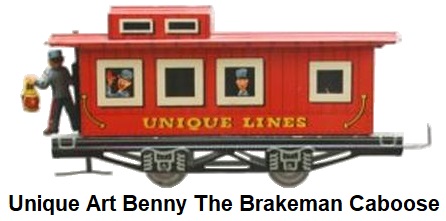
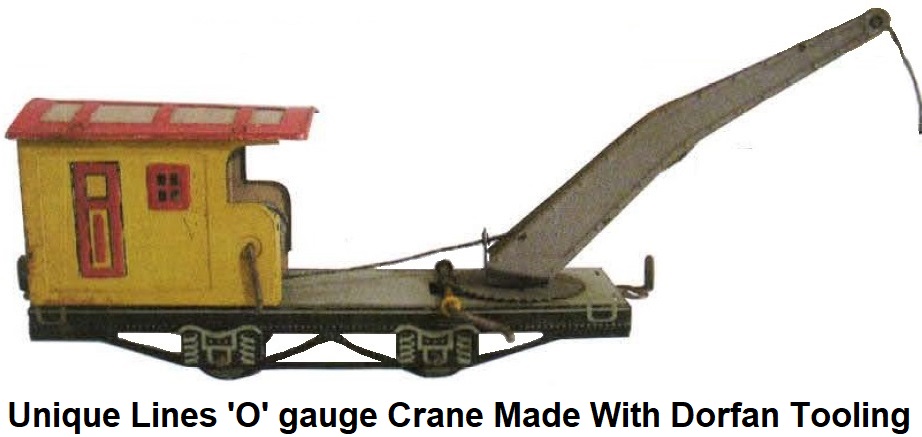
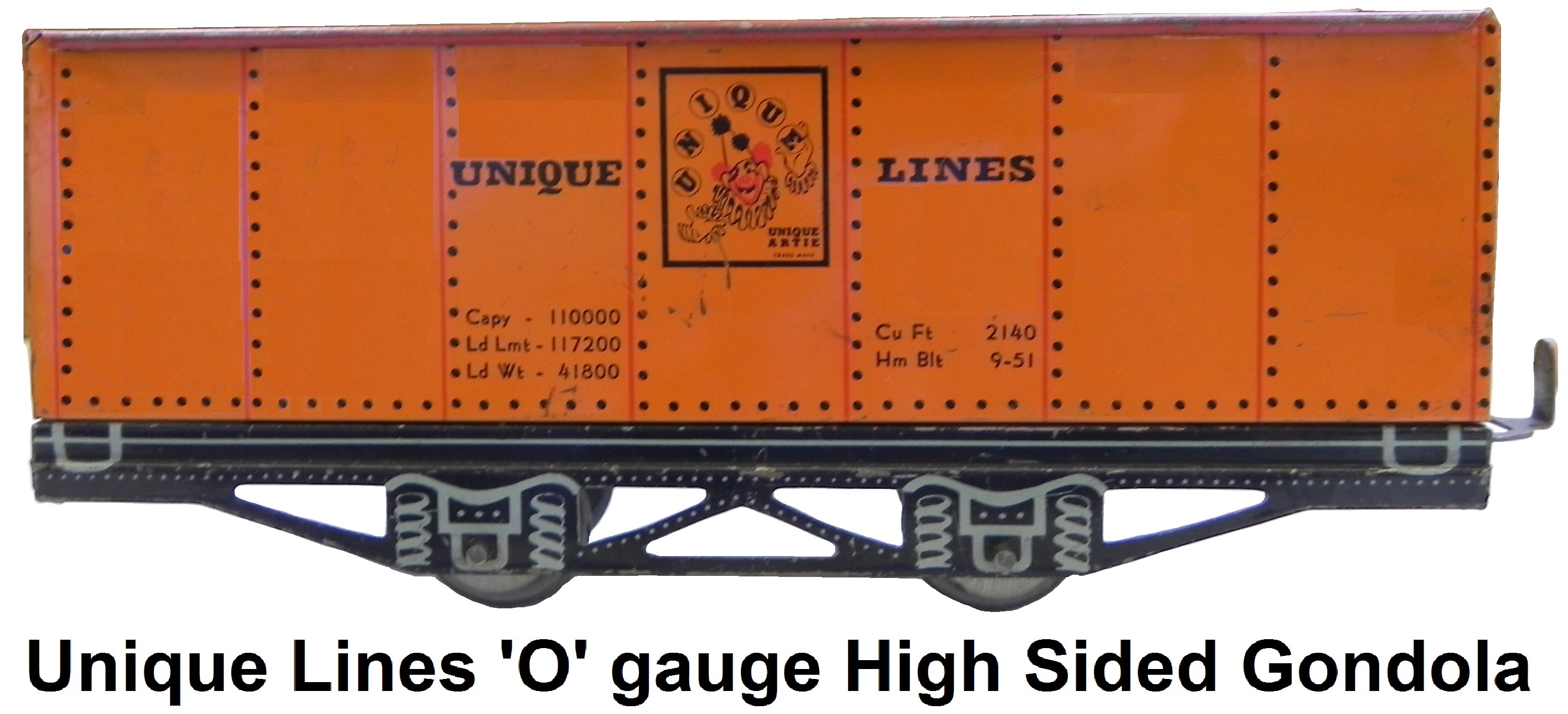
The Benny the Brakeman caboose featured a novelty that no other train manufacturer ever produced - a
brakeman that actually swung from the rear end of a caboose as it made its way around the track. The company logo was a clown,
named Unique Artie, juggling 6 balls that spelled out Unique. All train cars were labeled Unique Lines with a small copy of
this logo displayed somewhere on the car.
The advertising materials that promoted the Unique Lines Model #400 train set described the product as
being a, "Power packed colorful giant with built-in sturdiness and durability that will really take it!". This low end,
entry level set included a "heavy gauge all-steel" #742 clockwork powered locomotive equipped with a "sparkling mechanism"
which consisted of a common lighter flint and a rough and hardened stone-type knife sharpening wheel installed inside the
locomotive boiler and connected to the clockwork motor gearing so that as the engine moved around the track, sparks emanated
from the smokestack. This type of sparking mechanism was often employed by manufacturers in their operating toys as an added
feature to provide play value and stimulate the imaginiation. The locomotive also contained a "3-tone bell" that was
operated by a clanger that was attached to a wheel axle and rang as the train was in motion. The remainder of the set
featured a "Sturdy Tender to match the Locomotive", an "authentic Caboose with crew pictured in the windows", 8 sections of
'O' gauge curved and banked 2-rail track (enough to complete a 27 inch radius circle), and a replacement flint for the
locomotive spark mechanism. This set had a retail list price of $3.98.

Unique also produced a circus set that was both distributed on a car-by-car basis by the Jewel Companies,
that was labeled for Jewel T, and a version of its own, labeled Unique Lines. This set consisted of the standard #1950
locomotive with tender, two lithographed circus cars, and a caboose. The circus cars used the same box car frame but came with
two different lithograhed RR animal cage transport scenes. The cars that came in the Jewel T set had roofs, but the two cars
in the regular set did not. They were deep-sided gondolas with a lion in one and an elephant in the other, and were lettered
Unique Circus.
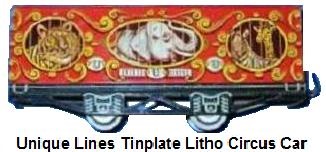
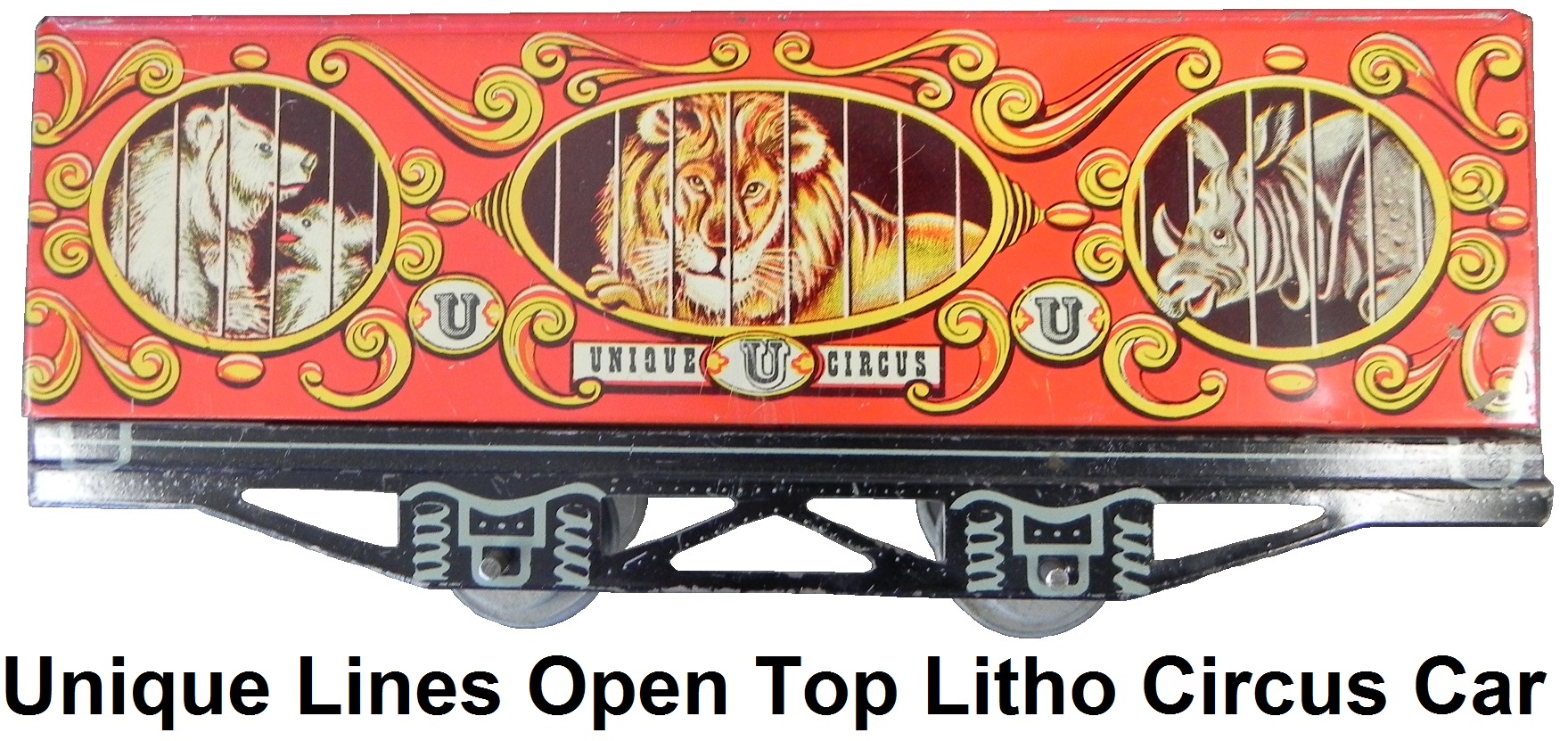
In 1950 Unique Art created a highly attractive set of F-7 style twin diesal locomotives using a process long abandonded by
most toy train manufacturers, who by now were producing model/toy trains exclusively in plastic. The lithographed #2000 Rock
Island RR locomotives, at 14" each (29" for the coupled AA units end-to-end) were longer than any other 'O' gauge diesel ever
made by the likes of Lionel, Marx, or American Flyer.
 The set was comprised of a power and a dummy unit, each equipped with a working headlight. The power unit had a single power
truck and a reversing mechanism. The power truck included two rubber tires to increase traction. These engines were highly
detailed with lithographed ladders, ventilators, handrails, access doors, portholes, number boards and radiators. The painted
heralds and road scheme were a very close approximation to the Rock Island RR prototype. It was listed at $10 retail. The
toylike appearance of these locomotives limited sales however, as young hobbyists were opting for the more scale-like and
realistic looking models of F3's being offered by Lionel. Bergman offered them with diesal coupler adapters that would
facilitate connecting Lionel and other knuckle coupler equipped cars. These Unique Lines diesal units also lacked the pulling
power to haul more than a few 'O' gauge cars from other manufacturers and appeared somewhat over-sized for pulling the Unique
Lines tinplate freight and passenger cars.
The set was comprised of a power and a dummy unit, each equipped with a working headlight. The power unit had a single power
truck and a reversing mechanism. The power truck included two rubber tires to increase traction. These engines were highly
detailed with lithographed ladders, ventilators, handrails, access doors, portholes, number boards and radiators. The painted
heralds and road scheme were a very close approximation to the Rock Island RR prototype. It was listed at $10 retail. The
toylike appearance of these locomotives limited sales however, as young hobbyists were opting for the more scale-like and
realistic looking models of F3's being offered by Lionel. Bergman offered them with diesal coupler adapters that would
facilitate connecting Lionel and other knuckle coupler equipped cars. These Unique Lines diesal units also lacked the pulling
power to haul more than a few 'O' gauge cars from other manufacturers and appeared somewhat over-sized for pulling the Unique
Lines tinplate freight and passenger cars.
The Unique Lines Deluxe Passenger Set #450P was listed for a suggested retail price of $4.49. It came with
a heavy gauge all steel #742 mechanical locomotive with bell, sparking mechanism, start-and-stop brake and windup key, a
tender to match, a City of Joplin Pullman car, a Garden City Pullman car, 8 sections of curved track, and a spare replacement
flint for the locomotive. The included 2-rail track facilitated a 27" circle (once around was 7 feet in distance). The train
measured 39½ inches end to end. Extra 9¾" long passenger cars could be acquired for $.49 retail. Just as
their Dorfan predecessors had, these passenger cars, built with the same tooling, featured tinplate litho candid portrait
miniatures of the passengers in the windows.

Louis Marx saw the development and sale of toy trains by Unique Art Manufacturing as a betrayal and
responded by creating a new line similar in size to Unique's, but with lithography that looked more realistic.
As a result, Unique found itself unable to compete, and withdrew its trains from the marketplace by 1951.
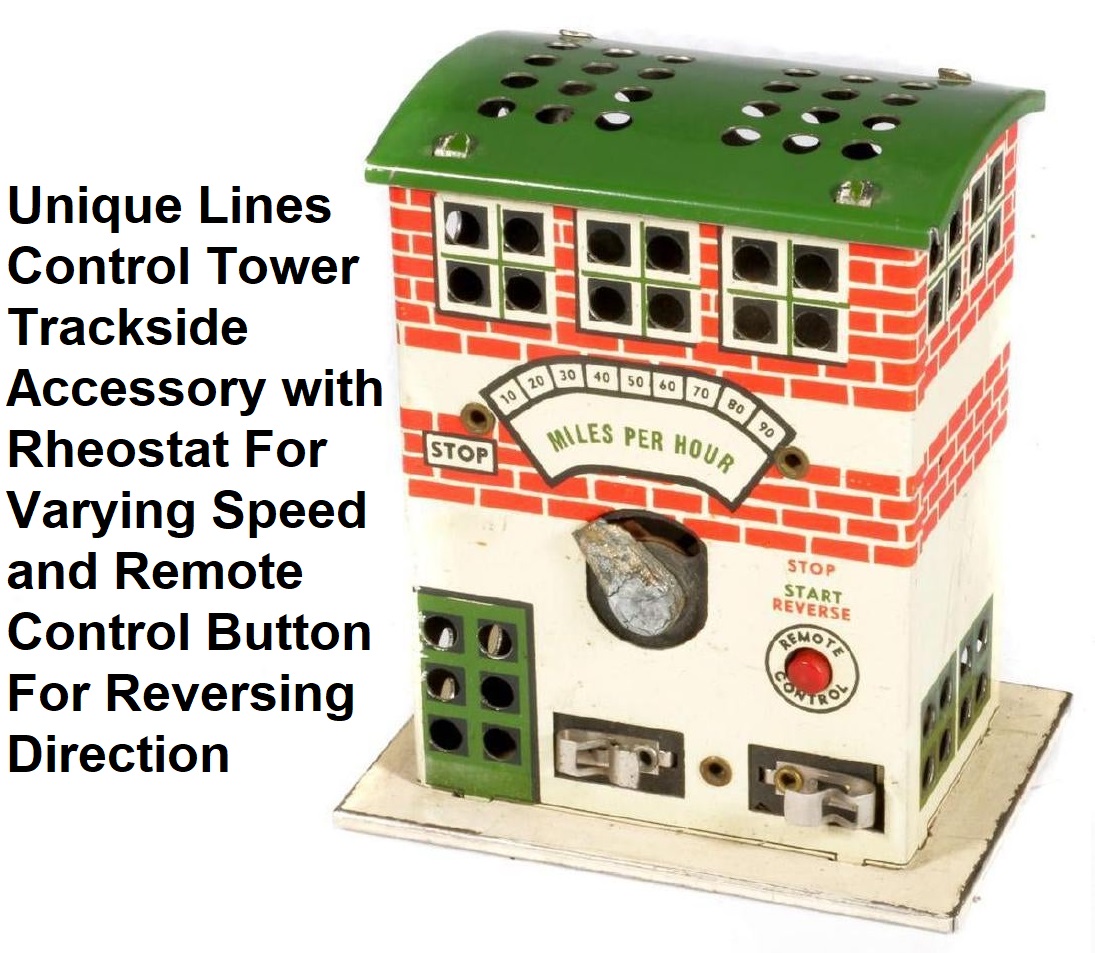 While only made for a brief period of a few years, the Unique Art Mfg. train items were colorful and
memorable, with novelty themes and unusal styling. Unique Line trains are often confused as being either Marx or
Hafner since they are compatible with those other tinplate 'O' and 'O-27' gauge lithographed train
systems, but they do not maintain or hold the same value among collectors. The tinplate lithographed passenger cars made from
the Dorfan dies and tooling are the hardest items to find, and are considered to be the most valuable of the Unique Lines
products, from a collectors perspective. Although Unique was not able to capture much of a piece of the toy train craze of the
early 1950's, a tin typewriter toy introduced during the same time frame did take market share away from Marx, who
had a similar toy. Marx responded by moving production of its typewriter toy to Japan in order to undercut Unique's price.
While only made for a brief period of a few years, the Unique Art Mfg. train items were colorful and
memorable, with novelty themes and unusal styling. Unique Line trains are often confused as being either Marx or
Hafner since they are compatible with those other tinplate 'O' and 'O-27' gauge lithographed train
systems, but they do not maintain or hold the same value among collectors. The tinplate lithographed passenger cars made from
the Dorfan dies and tooling are the hardest items to find, and are considered to be the most valuable of the Unique Lines
products, from a collectors perspective. Although Unique was not able to capture much of a piece of the toy train craze of the
early 1950's, a tin typewriter toy introduced during the same time frame did take market share away from Marx, who
had a similar toy. Marx responded by moving production of its typewriter toy to Japan in order to undercut Unique's price.
Unique Art's eventual fate is unclear but the toy company appears to have disappeared by 1952. There is
some evidence that Marx may have acquired the line later on, but never produced it, as samples of Unique Art products were
discovered in the Marx archives.
